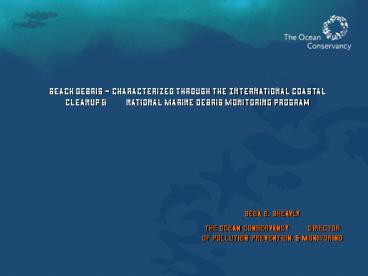EPA Presentation - PowerPoint PPT Presentation
1 / 41
Title: EPA Presentation
1
Beach Debris characterized through the
International Coastal Cleanup National
Marine Debris Monitoring Program
Seba B. Sheavly The Ocean Conservancy
Director of Pollution Prevention Monitoring
2
1960s to 1980s Research on ocean dumping from
ships
3
Research on animal entanglement ingestion
4
Impacts of Debris on the Aquatic Environment
- Animal entanglement ingestion
- Habitat destruction
- Human health safety
- Vessel disablement
- Economics aesthetics
5
International Coastal Cleanup (ICC) The ICC
engages people to remove trash and debris from
the worlds beaches and waterways, to identify
the sources of debris, and to change the
behaviors that cause pollution.
6
Ocean-based Waterway Sources
APEC Marine Debris SeminarJanuary 13-16, 2004
7
(No Transcript)
8
(No Transcript)
9
Land-based Sources
10
(No Transcript)
11
(No Transcript)
12
ICC Data Card
- Shoreline and Recreational Activities
- Ocean and Waterway Activities
- Smoking-Related Activities
- Dumping Activities
- Medical/Personal Hygiene
13
MARINE DEBRIS ACTIVITIES SOURCES
14
Data Collection
15
International Marine Debris Database
- One of the ICCs goals is to trace pollution to
its source and work to prevent it. - ICC volunteers record debris information on
standardized data cards developed by The Ocean
Conservancy.
16
From 1986-2005, more than 84 million pieces of
data on debris were entered into the database,
from 127 countries.
17
ICC data analyses reports have
- Influenced public policy on waste management
- Prompted national legislation
- Influenced manufacturing practices of industries
related to packaging - Convinced individuals, organizations, and
communities to examine their waste handling
practices
18
International Coastal Cleanup U.S. Debris Items
by Source Activities
19
International Coastal Cleanup U.S. Debris Items
by Source Activities
20
International Coastal Cleanup U.S. Debris Items
by Source Activities
21
International Coastal Cleanup U.S. Debris Source
Percentages
22
ICC U.S. Pacific Coast (CA, OR, WA) Debris
Items by Source Activities
23
ICC U.S. Pacific Coast (CA, OR, WA) Debris
Items by Source Activities
24
ICC U.S. Pacific Coast (CA, OR, WA) Debris
Items by Source Activities
25
International Coastal Cleanup U.S. Pacific Coast
(CA, OR, WA) Debris Source Percentages
26
(No Transcript)
27
National Marine Debris Monitoring Program
(NMDMP)
28
NMDMP Overview
- Sites in nine regions (19 states 2 territories)
- Data collected from 130 Sites
- Over 600 volunteers
- 6,859 surveys to date
29
Marine Debris Study
- A scientific protocol conducted every 28 days
- Study designed to answer two specific questions
- Is debris increasing or decreasing?
- What are the main sources of debris?
- Measure a 30 change in 30 marine debris items
over the course of five-years with a Type I error
rate of 0.10 and Power of 0.84
30
NMDMP Data Card
- Weather Information
- Safety Tips
- Entangled Animals
- Foreign Labels
Return data card
Nat. Mar. Debris Monitoring Prog.
3500 VA Beach Blvd.,
Suite 212 VA Beach, VA 23452
31
Ocean-Based Debris
NMDMP Data Card
30 debris items
Land-Based Debris
General Debris
32
NMDMP Regions 6 7 Fall Quarter
2002 2004
33
NMDMP Region 6 Fall Quarter Debris Items
34
NMDMP Region 6 Fall Quarter (Sep.
Nov.) Debris Source Percentages
35
NMDMP Region 7 Fall Quarter Debris Items
36
NMDMP Region 7 Fall Quarter (Sep.
Nov.) Debris Source Percentages
37
Debris Source Percentages Pacific Coast 2002-2004
NMDMP
ICC
38
How do we deal with marine debris?
- Education Outreach
- Regular Monitoring
- Stakeholder Engagement
- Govt., Business Industry Involvement
- Regulations Enforcement
- Innovations Incentives
39
(No Transcript)
40
41
(No Transcript)































